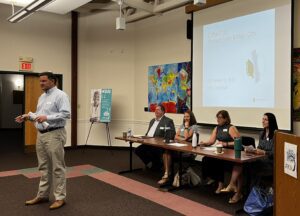PG and MG: What’s the BD?
By Heather Hise
Vice President, Marketing & Communications, and Senior Consultant

Enough with the acronyms, already! What’s the big deal (BD) with planned giving (PG) and major gifts (MG)? Last week, we gathered with some local nonprofit professionals to discuss just that.
In case you missed it (ICYMI), here’s the CliffsNotes version from our presenters!
Major Gifts
- Because many people are moving away from advancement and development careers, stewardship and cultivation are suffering as remaining team members’ attention is pulled elsewhere.
- Q: How do you eat an elephant? (Not that we would.) A. One bite at a time. Small bites. Don’t be overwhelmed by your donor list. Identify five people and engage them to help develop your major gifts portfolio.
- Analyze donor data: Who is giving to you – when and why?
- Familiarize yourself with moves management which tracks an individual to prospective donor, then first-time donor and onward to a major donor (identification, qualification, cultivation, solicitation, stewardship).
- Make giving easy: Do you have policies about gifts such as stock and real estate? Look at your giving touchpoints and platforms – is it easy for them to give in these ways?
- Look creatively at donor-advised funds (DAFs). Funding organizations can help guide donors in their decision-making process. Make it clear on your website and other gift points (events, pledge forms, etc.) that are happy to accept DAFs. And get to know the fund’s program managers so they’re aware of your fundraising priorities – they may be able to match you with a donor who isn’t even on your radar.
- Leverage marketing and communications to meet your goals: Completely fill out your GuideStar profile and keep all information current. Differentiate your organization by sharing how you can make their dollars go further. Personalize the thank-you experience to your organization – perhaps consider including thank-you notes from people served with your own letter of appreciation. And importantly, are your funding opportunities aligned with your organization’s mission and strategic goals?
Planned Giving
- Most planned giving donors have consistently and regularly made smaller gifts to the organization; they are not necessarily the same people on your major gifts list.
- After planned giving is decided, donors are 16% more likely to increase their gifts to the organization and are 63% more likely to remain a regular donor.
- Like major gifts, some donors want to talk and plan with you, while others will pleasantly surprise you when your organization receives their funds.
- Managing planned giving donors means cultivating the gift they’ve made in their hearts – this is a donor from whom you may not see a penny while they are alive.
- Rather than create specific planned giving materials, incorporate the program into everything you do. For example, ask the question in your newsletter, “Have you considered leaving us a gift in your will?”
- Thank and cultivate the donor’s family after they’ve passed by including them in your giving society.
We only had to time to scratch the surface at our coffee chat, but if we’ve piqued your interest, reach out to any of our presenters for more information on developing major gifts or planned giving programs.
Contact Lisa Resnik, Chief Operating Officer and Senior Consultant
Contact Kacy Noltemeyer, Vice President, Fundraising Solutions, and Senior Consultant
Contact Chris McGown, Planned Giving Consultant
